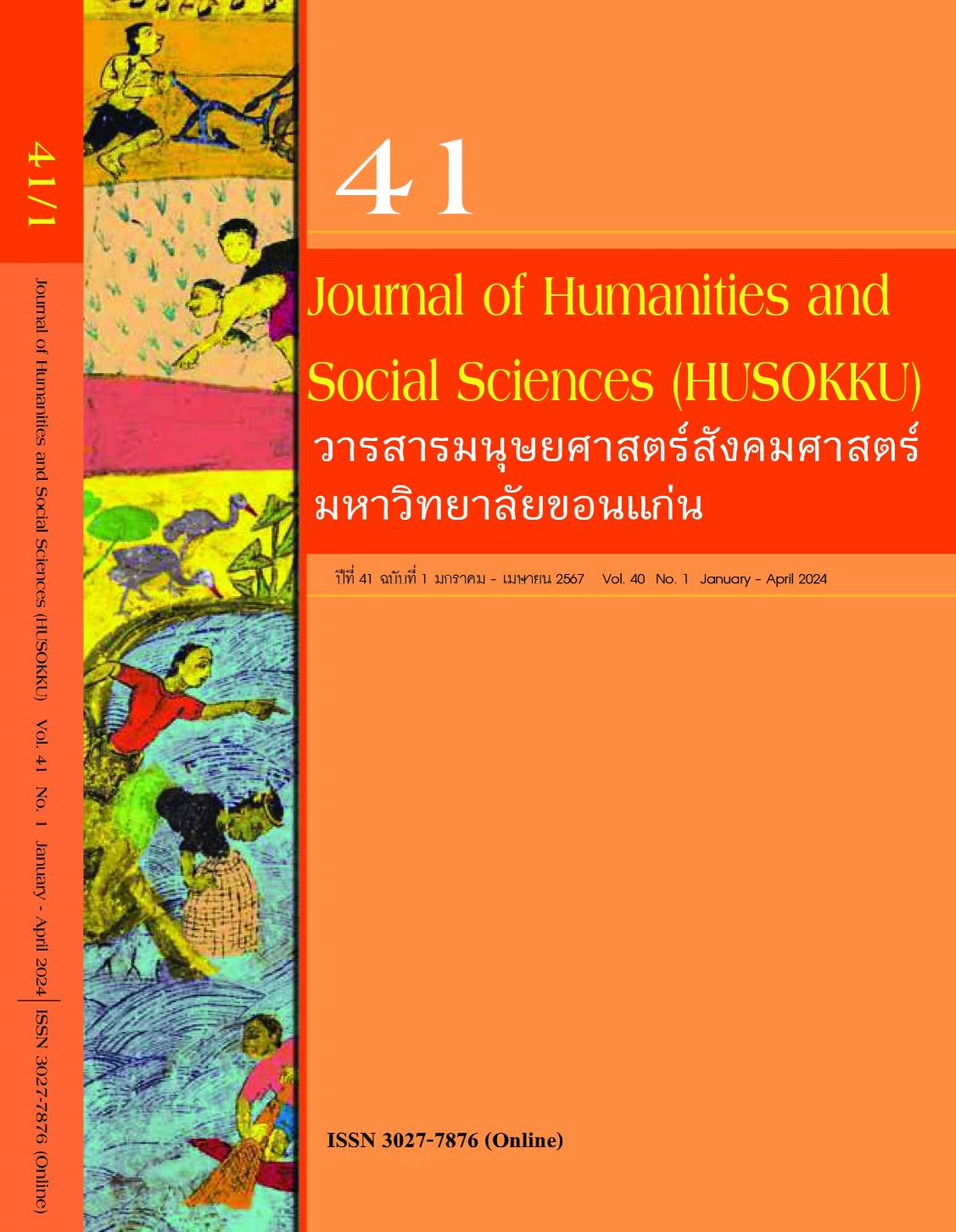กระบวนการสร้างความมั่นคงด้านเศรษฐกิจของผู้หญิงที่สามีย้ายถิ่นไปทำงานต่างประเทศ
The Process of Economic Security of Women whose Husbands Migrate to work Abroad
Keywords:
The process of economic security; International migrationAbstract
บทคัดย่อ
บทความนี้มุ่งศึกษากระบวนการสร้างความมั่นคงด้านเศรษฐกิจของผู้หญิงที่สามีย้ายถิ่นไปทำงานต่างประเทศ ใช้ระเบียบวิธีวิจัยเชิงคุณภาพ มีหน่วยการวิเคราะห์ระดับบุคคล เก็บข้อมูลจากผู้หญิงที่สามีย้ายถิ่นไปทำงานต่างประเทศจำนวน 20 ราย ในหมู่บ้านแห่งหนึ่ง อำเภอเมือง จังหวัดนครพนม ซึ่งเป็นพื้นที่ที่มีการย้ายถิ่นไปทำงานต่างประเทศของแรงงานอย่างต่อเนื่อง เก็บรวบรวมข้อมูลเมื่อกันยายน 2565 วิเคราะห์ข้อมูลด้วยการตีความหมายตามแก่นสาระ (Thematic Analysis) และนำเสนอข้อมูลด้วยการพรรณนาวิเคราะห์ ผลการศึกษาพบว่า ผู้หญิงมีกระบวนการสร้างความมั่นคงด้านเศรษฐกิจ 3 ระยะ ได้แก่ ระยะที่ 1 แสวงหาหนทางและทุน ระยะที่ 2 จัดการหนี้สิน ระยะที่ 3 สร้างเนื้อสร้างตัว
คำสำคัญ: กระบวนการสร้างความมั่นคงด้านเศรษฐกิจ, การย้ายถิ่นไปทำงานต่างประเทศ
References
ชาย โพธิสิตา. (2562). ศาสตร์และศิลป์แห่งการวิจัยเชิงคุณภาพ. นครปฐม:
สถาบันวิจัยประชากรและสังคม มหาวิทยาลัยมหิดล.
สุภางค์ จันทวานิช และคณะ. (2547). การเตรียมความพร้อมเพื่อการคุ้มครองแรงงานไทยที่ไปทำงานต่างประเทศ: การวิจัยเชิงปฏิบัติการแบบมีส่วนร่วมเพื่อพัฒนารูปแบบ. กรุงเทพฯ: โครงการวิจัยเมธีวิจัยอาวุโส สกว.
อารี จำปากลาย และคณะ. (2556). ลูกๆ เป็นอย่างไร เมื่อพ่อแม่ย้ายถิ่น โครงการ CLAIM. นครปฐม: สถาบันวิจัยประชากรและสังคม มหาวิทยาลัยมหิดล.
Alkire, A. A. (1969). Social power and communication within families of disturbed and nondisturbed preadolescents. Journal of Personality and Social Psychology, 13(4), 335–349.
Allen, S. and Truman, C. (2020). Women in Business: Perspectives on Women Entrepreneurs. London.
Ayuwat, D. (2019). Isan Migrant on the Move: Situations and Impacts. Khon Kaen: Klangnana Wittaya.
Ayuwat, et al. (2019). Factors Influencing the Happiness of Migrant Labour households in the Northeast, Thailand. International Journal of Recent Technology and Engineering, 8(1C2), 875-883.
Chamratrithirong, A. et al. (2006). Migration and Gender-based Occupational Segregation in Bangkok. Journal of Population and Social Studies, 15(1), 53-80.
Datta, A. and Mishra, S.K. (2011). IMPACT OF MALE MIGRATION ON WOMEN’S LIVES IN RURAL BIHAR. The Indian Journal of Labour Economics, 54(3).
Fisher, P.J., Hayhoe, C.R., and Lown, J.M. (2015). Gender differences in saving behaviors among low- to-moderate-income households. Financial Services Review. 24, 1-13.
Karymshakov, K. and Sulaimanova, B. (2017). Migration Impact on Left-Behind Women’s Labour Participation and Time-Use. United Nations University World Institute for Development Economics Research.
Khamnoi, S. and Ayuwat, D. (2019). Roles in Public Space of Wives Who Left Behind International Migrant Husbands. Journal of Economics and Business, 2(3), 586-592.
Lusardi, A and Mitchell, O. S.. (2008). “Financial Literacy and Retirement Preparedness: Evidence and Implications for Financial Education,” Business Economics,
(1): 35-44.
Todaro, M.P. (1976). Internal Migration in Developing Countries. Geneva International
Labour Office.



